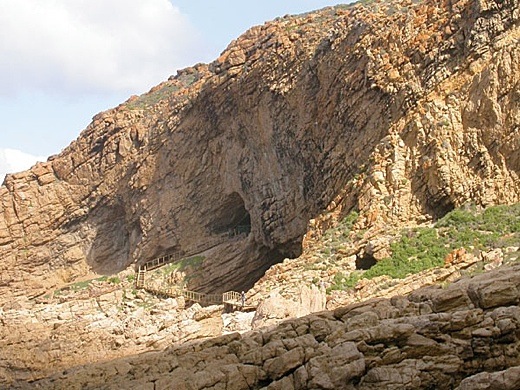SUBHEAD: Almost 200,000 years ago humans faced extinction. Only a few hundred were saved along the coast of Cape Horn.
By Curtiss W. Marean on 21 July 2010 for Scientific American -
(http://www.scientificamerican.com/article.cfm?id=when-the-sea-saved-humanity)
 Image above: The shoreline near Cape Horn, South Africa. From (http://www.holidaydestinationsa2z.org/index.php?section=pages&item=Western-Cape).
Image above: The shoreline near Cape Horn, South Africa. From (http://www.holidaydestinationsa2z.org/index.php?section=pages&item=Western-Cape).
Shortly after
Homo sapiens arose harsh climate conditions nearly extinguished our species. Recent finds suggest that the small population that gave rise to all humans alive today survived by exploiting a unique combination of resources along the southern coast of Africa.
With the global population of humans currently approaching seven billion, it is difficult to imagine that
Homo sapiens was once an endangered species. Yet studies of the DNA of modern-day people indicate that, once upon a time, our ancestors did in fact undergo a dramatic population decline.
Although scientists lack a precise timeline for the origin and near extinction of our species, we can surmise from the fossil record that our forebears arose throughout Africa shortly before 195,000 years ago.
Back then the climate was mild and food was plentiful; life was good. But around 195,000 years ago, conditions began to deteriorate. The planet entered a long glacial stage known as Marine Isotope Stage 6 (MIS6) that lasted until roughly 123,000 years ago.
A detailed record of Africa’s environmental conditions during Glacial Stage 6 does not exist, but based on more recent, better-known glacial stages, climatologists surmise that it was almost certainly cool and arid and that its deserts were probably significantly expanded relative to their modern extents.
Much of the landmass would have been uninhabitable. While the planet was in the grip of this icy regime, the number of people plummeted perilously—from more than 10,000 breeding individuals to just hundreds.
Estimates of exactly when this bottleneck occurred and how small the population became vary among genetic studies, but all of them indicate that everyone alive today is descended from a small population that lived in one region of Africa sometime during this global cooling phase.
I began my career as an archaeologist working in East Africa and studying the origin of modern humans.
But my interests began to shift when I learned of the population bottleneck that geneticists had started talking about in the early 1990s.
Humans today exhibit very low genetic diversity relative to many other species with much smaller population sizes and geographic ranges—a phenomenon best explained by the occurrence of a population crash in early
H. sapiens.
Where, I wondered, did our ancestors manage to survive during the climate catastrophe? Only a handful of regions could have had the natural resources to support hunter-gatherers.
Paleoanthropologists argue vociferously over which of these areas was the ideal spot. The southern coast of Africa, rich in shellfish and edible plants year-round, seemed to me as if it would have been a particularly good refuge in tough times.
So, in 1991, I decided I would go there and look for sites with remains dating to Glacial Stage 6.
My search within that coastal area was not random. I had to find a shelter close enough to the ancient coastline to provide easy access to shellfish and elevated enough that its archaeological deposits would not have been washed away 123,000 years ago when the climate warmed and sea levels surged.
In 1999 my South African colleague Peter Nilssen and I decided to investigate some caves he had spotted at a place called Pinnacle Point, a promontory near the town of Mossel Bay that juts into the Indian Ocean.
Scrambling down the sheer cliff face, we came across a cave that looked particularly promising—one known simply as PP13B. Erosion of the sedimentary deposits located near the mouth of the cave had exposed clear layers of archaeological remains, including hearths and stone tools.
Even better, a sand dune and a layer of stalagmite capped these remnants of human activity, suggesting that they were quite old. By all appearances, we had hit the jackpot. The following year, after a local ostrich farmer built us a 180-step wooden staircase to allow safer access to the site, we began to dig.
Since then, my team’s excavations at PP13B and other nearby sites have recovered a remarkable record of the activities undertaken by the people who inhabited this area between approximately 164,000 and 35,000 years ago, hence during the bottleneck and after the population began to recover.
The deposits in these caves, combined with analyses of the ancient environment there, have enabled us to piece together a plausible account of how the prehistoric residents of Pinnacle Point eked out a living during a grim climate crisis.
The remains also debunk the abiding notion that cognitive modernity evolved long after anatomical modernity: evidence of behavioral sophistication abounds in even the oldest archaeological levels at PP13B. This advanced intellect no doubt contributed significantly to the survival of the species, enabling our forebears to take advantage of the resources available on the coast.
While elsewhere on the continent populations of
H. sapiens died out as cold and drought claimed the animals and plants they hunted and gathered, the lucky denizens of Pinnacle Point were feasting on the seafood and carbohydrate-rich plants that proliferated there despite the hostile climate.
As Glacial Stage 6 cycled through its relatively warmer and colder phases, the seas rose and fell, and the ancient coastline advanced and retreated. But so long as people tracked the shore, they had access to an enviable bounty.
A Coastal Cornucopia
From a survival standpoint, what makes the southern edge of Africa attractive is its unique combination of plants and animals. There a thin strip of land containing the highest diversity of flora for its size in the world hugs the shoreline. Known as the Cape Floral Region, this 90,000- square-kilometer strip contains an astonishing 9,000 plant species, some 64 percent of which live only there.
Indeed, the famous Table Mountain that rises above Cape Town in the heart of the Cape Floral Region has more species of plants than does the entire U.K. Of the vegetation groups that occur in this realm, the two most extensive are the fynbos and the renosterveld, which consist largely of shrubs.
To a human forager equipped with a digging stick, they offer a valuable commodity: the plants in these groups produce the world’s greatest diversity of geophytes—underground energy-storage organs such as tubers, bulbs and corms.
Geophytes are an important food source for modern-day hunter-gatherers for several reasons. They contain high amounts of carbohydrate; they attain their peak carbohydrate content reliably at certain times of year; and, unlike aboveground fruits, nuts and seeds, they have few predators.
The bulbs and corms that dominate the Cape Floral Region are additionally appealing because in contrast to the many geophytes that are highly fibrous, they are low in fiber relative to the amount of energy-rich carbohydrate they contain, making them more easily digested by children. (Cooking further enhances their digestibility.)
And because geophytes are adaptations to dry conditions, they would have been readily available during arid glacial phases.
The southern coast also has an excellent source of protein to offer, despite not being a prime hunting ground for large mammals. Just offshore, the collision of nutrient-rich cold waters from the Benguela upwelling and the warm Agulhas current creates a mix of cold and warm eddies along the southern coast.
This varied ocean environment nurtures diverse and dense beds of shellfish in the rocky intertidal zones and sandy beaches. Shellfish are a very high quality source of protein and omega-3 fatty acids. And as with geophytes, glacial cooling does not depress their numbers. Rather, lower ocean temperatures result in a greater abundance of shellfish.
 Image above:Kirstenbosch Botanic Gardens in the Cape Flora highlands of South Africa. From (http://www.fotopedia.com/items/flickr-4274271451).
Survival Skills
Image above:Kirstenbosch Botanic Gardens in the Cape Flora highlands of South Africa. From (http://www.fotopedia.com/items/flickr-4274271451).
Survival Skills
With its combination of calorically dense, nutrient-rich protein from the shellfish and low-fiber, energy-laden carbs from the geophytes, the southern coast would have provided an ideal diet for early modern humans during Glacial Stage 6.
Furthermore, women could obtain both these resources on their own, freeing them from relying on men to provision them and their children with high-quality food.
We have yet to unearth proof that the occupants of PP13B were eating geophytes—sites this old rarely preserve organic remains—although younger sites in the area contain extensive evidence of geophyte consumption. But we have found clear evidence that they were dining on shellfish.
Studies of the shells found at the site conducted by Antonieta Jerardino of the University of Barcelona show that people were gathering brown mussels and local sea snails called alikreukel from the seashore. They also ate marine mammals such as seals and whales on occasion.
Previously the oldest known examples of humans systematically using marine resources dated to less than 120,000 years ago.
But dating analyses performed by Miryam Bar-Matthews of the Geological Survey of Israel and Zenobia Jacobs of University of Wollongong in Australia have revealed that the PP13B people lived off the sea far earlier than that: as we reported in 2007 in the journal
Nature, marine foraging there dates back to a stunning 164,000 years ago. By 110,000 years ago the menu had expanded to include species such as limpets and sand mussels.
This kind of foraging is harder than it might seem. The mussels, limpets and sea snails live on the rocks in the treacherous intertidal zone, where an incoming swell could easily knock over a hapless collector.
Along the southern coast, safe harvesting with sufficiently high returns is only possible during low spring tides, when the sun and moon align, exerting their maximum gravitational force on the ebb and flow of the water.
Because the tides are linked to the phases of the moon, advancing by 50 minutes a day, I surmise that the people who lived at PP13B—which 164,000 years ago was located much farther inland, two to five kilometers from the water, because of lower sea levels—scheduled their trips to the shore using a lunar calendar of sorts, just as modern coastal people have done for ages.
Harvesting shellfish is not the only advanced behavior in evidence at Pinnacle Point as early as 164,000 years ago. Among the stone tools are significant numbers of “bladelets”—tiny flakes twice as long as they are wide—that are too small to wield by hand. Instead they must have been attached to shafts of wood and used as projectile weapons.
Composite toolmaking is indicative of considerable technological know-how, and the bladelets at PP13B are among the oldest examples of it. But we soon learned that these tiny implements were even more complex than we thought.
Most of the stone tools found at coastal South African archaeological sites are made from a type of stone called quartzite. This coarse-grained rock is great for making large flakes, but it is difficult to shape into small, refined tools.
To manufacture the bladelets, people used fine-grained rock called silcrete. There was something odd about the archaeological silcrete, though, as observed by Kyle S. Brown of the Institute of Human Origins at Arizona State University, an expert stone tool flaker on my team.
After years of collecting silcrete from all over the coast, Brown determined that in its raw form the rock never has the lustrous red and gray coloring seen in the silcrete implements at Pinnacle Point and elsewhere. Furthermore, the raw silcrete is virtually impossible to shape into bladelets. Where, we wondered, did the toolmakers find their superior silcrete?
A possible answer to this question came from Pinnacle Point Cave 5-6, where one day in 2008 we found a large piece of silcrete embedded in ash. It had the same color and luster seen in the silcrete found at other archaeological deposits in the region.
Given the association of the stone with the ash, we asked ourselves whether the ancient toolmakers might have exposed the silcrete to fire to make it easier to work with—a strategy that has been documented in ethnographic accounts of native North Americans and Australians.
To find out, Brown carefully “cooked” some raw silcrete and then attempted to knap it. It flaked wonderfully, and the flaked surfaces shone with the same luster seen in the artifacts from our sites.
We thus concluded that the Stone Age silcrete was also heat-treated.
We faced an uphill battle to convince our colleagues of this remarkable claim, however. It was archaeology gospel that the Solutrean people in France invented heat treatment about 20,000 years ago, using it to make their beautiful tools.
To bolster our case, we used three independent techniques. Chantal Tribolo of the University of Bordeaux performed what is called thermoluminescence analysis to determine whether the silcrete tools from Pinnacle Point were intentionally heated.
Then Andy Herries of the University of New South Wales in Australia employed magnetic susceptibility, which looks for changes in the ability of rock to be magnetized—another indicator of heat exposure among iron-rich rocks.
Finally, Brown used a gloss meter to measure the luster that develops after heating and flaking and compare it with the luster on the tools he made. Our results, detailed last year in the journal
Science, showed that intentional heat treatment was a dominant technology at Pinnacle Point by 72,000 years ago and that people there employed it intermittently as far back as 164,000 years ago.
The process of treating by heat testifies to two uniquely modern human cognitive abilities.
First, people recognized that they could substantially alter a raw material to make it useful—in this case, engineering the properties of stone by heating it, thereby turning a poor-quality rock into high-quality raw material. Second, they could invent and execute a long chain of processes.
The making of silcrete blades requires a complex series of carefully designed steps: building a sand pit to insulate the silcrete, bringing the heat slowly up to 350 degrees Celsius, holding the temperature steady and then dropping it down slowly.
Creating and carrying out the sequence and passing technologies down from generation to generation probably required language. Once established, these abilities no doubt helped our ancestors outcompete the archaic human species they encountered once they dispersed from Africa.
In particular, the complex pyrotechnology detected at Pinnacle Point would have given early modern humans a distinct advantage as they entered the cold lands of the Neandertals, who seem to have lacked this technique.

Image above: Pinnacle Point Cave (PP13B) as it appears today. From (http://scopeweb.mit.edu/?p=151#more-151).
Smart from the Start
In addition to being technologically savvy, the prehistoric denizens of Pinnacle Point had an artistic side. In the oldest layers of the PP13B sequence, my team has unearthed dozens of pieces of red ochre (iron oxide) that were variously carved and ground to create a fine powder that was probably mixed with a binder such as animal fat to make paint that could be applied to the body or other surfaces.
Such decorations typically encode information about social identity or other important aspects of culture—that is, they are symbolic. Many of my colleagues and I think that this ochre constitutes the earliest unequivocal example of symbolic behavior on record and pushes the origin of such practices back by tens of thousands of years.
Evidence of symbolic activities also appears later in the sequence. Deposits dating to around 110,00 years ago include both red ochre and seashells that were clearly collected for their aesthetic appeal, because by the time they washed ashore from their deepwater home, any flesh would have been long gone.
I think these decorative seashells, along with the evidence for marine foraging, signal that people had, for the first time, begun to embed in their worldview and rituals a clear commitment to the sea.
The precocious expressions of both symbolism and sophisticated technology at Pinnacle Point have major implications for understanding the origin of our species.
Fossils from Ethiopia show that anatomically modern humans had evolved by at least 195,000 years ago. The emergence of the modern mind, however, is more difficult to establish.
Paleoanthropologists use various proxies in the archaeological record to try to identify the presence and scope of cognitive modernity.
Artifacts made using technologies that require outside-the-box connections of seemingly unrelated phenomena and long chains of production—like heat treatment of rock for tool manufacture—are one proxy. Evidence of art or other symbolic activities is another, as is the tracking of time through proxies such as lunar phases.
For years the earliest examples of these behaviors were all found in Europe and dated to after 40,000 years ago. Based on that record, researchers concluded that there was a long lag between the origin of our species and the emergence of our peerless creativity.
But over the past 10 years archaeologists working at a number of sites in South Africa have found examples of sophisticated behaviors that predate by a long shot their counterparts in Europe. For instance, archaeologist Ian Watts, who works in South Africa, has described hundreds to thousands of pieces of worked and unworked ochre at sites dating as far back as 120,000 years ago.
Interestingly, this ochre, as well as the pieces at Pinnacle Point, tends to be red despite the fact that local sources of the mineral exhibit a range of hues, suggesting that humans were preferentially curating the red pieces—perhaps associating the color with menstruation and fertility.
Jocelyn A. Bernatchez, a Ph.D. student at Arizona State, thinks that many of these ochre pieces may have been yellow originally and then heat-treated to turn them red.
And at Blombos Cave, located about 100 kilometers west of Pinnacle Point, Christopher S. Henshilwood of the University of Bergen in Norway has discovered pieces of ochre with systematic engravings, beads made of snail shells and refined bone tools, all of which date to around 71,000 years ago [see “
The Morning of the Modern Mind,” by Kate Wong;
Scientific American, June 2005].
These sites, along with those at Pinnacle Point, belie the claim that modern cognition evolved late in our lineage and suggest instead that our species had this faculty at its inception.
I suspect that a driving force in the evolution of this complex cognition was strong long-term selection acting to enhance our ancestors’ ability to mentally map the location and seasonal variation of many species of plants in arid environments and to convey this accumulated knowledge to offspring and other group members.
This capacity laid the foundation for many other advances, such as the ability to grasp the link between the phases of the moon and the tides and to learn to schedule their shellfish-hunting trips to the shore accordingly. Together the readily available shellfish and geophytes provided a high-quality diet that allowed people to become less nomadic, increased their birth rates and reduced their child mortality.
The larger group sizes that resulted from these changes would have promoted symbolic behavior and technological complexity as people endeavored to express their social identity and build on one another’s technologies, explaining why we see such sophisticated practices at PP13B.
Follow the Sea
PP13B preserves a long record of changing occupations that, in combination with the detailed records of local climate and environmental change my team has obtained, is revealing how our ancestors used the cave and the coast over millennia.
Modeling the paleocoastline over time, Erich C. Fisher of the University of Florida has shown that the conditions changed quickly and dramatically, thanks to a long, wide, gently sloping continental shelf off the coast of South Africa called the Agulhas bank.
During glacial periods, when sea levels fell, significant amounts of this shelf would have been exposed, putting considerable distance—up to 95 kilometers—between Pinnacle Point and the ocean. When the climate warmed and sea levels rose, the water advanced over the Agulhas bank again, and the caves were seaside once more.
Judging from rainfall and vegetation patterns evident in records from stalagmites spanning the time between 350,000 and 50,000 years ago, we see that the fynbos probably followed the retreating coast out onto the now submerged continental shelf and back again, keeping the geophytes and shellfish in close proximity.
As for the people, during these periods of low population density they were free to target the best part of the landscape, and that was the intersection of the geophytes and shellfish—so I suspect they followed the sea. The tracking of resources would explain why PP13B appears to have been occupied intermittently.
Our excavations at PP13B have intercepted the people who may very well be the ancestors of everyone on the planet as they shadowed the shifting shoreline. Yet if I am correct about these people and their connection to the coast, the richest record of the progenitor population lies underwater on the Agulhas bank.
There it will remain for the near future, guarded by great white sharks and dangerous currents. We can still test the hypothesis that humans followed the sea by examining sites on the current coast such as PP13B and another site we are excavating called PP5-6. But we can also study locations where the continental shelf drops steeply and the coast was always near—investigations that my colleagues and I are currently initiating.
The genetic, fossil and archaeological records are reasonably concordant in suggesting that the first substantial and prolonged wave of modern human migration out of Africa occurred around 50,000 years ago. But questions about the events leading up to that exodus remain.
We still do not know, for example, whether at the end of Glacial Stage 6 there was just one population of
H. sapiens left in Africa or whether there were several, with just one ultimately giving rise to everyone alive today.
Such unknowns are providing my team and others with a very clear and exciting research direction for the foreseeable future: our fieldwork needs to target the other potential progenitor zones in Africa during that glacial period and expand our knowledge of the climate conditions just before that stage.
We need to flesh out the story of these people who eventually pushed out of their refuge, filled up the African continent and went on to conquer the world.
. 






